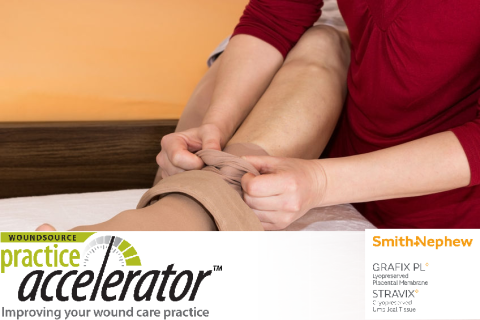Preventing Recurrent Lower Extremity Wounds
February 28, 2021
Chronic and complex wounds of the lower extremity frequently recur. It is difficult to determine the precise recurrence rate across patients with different lower extremity wound types, including diabetic foot ulcers, arterial ulcers, pressure injuries, and venous ulcers. However, we know that recurrence rates are high; nearly 40% of patients with an ulcer will develop a recurrence within one year of healing. This percentage is 60% at three years after healing and 65% at the five-year mark.1 Venous ulcers are characterized by repeated cycles of healing and recurrence in 60% to 70% of patients.2
Recurrence rates are so high that some clinicians consider lower extremity wound closure to be a form of remission rather than complete healing. The thought behind this is that the concept of remission can provide a better framework for allocating resources, organizing care, and communicating information to patients about risk.3 However, preventing recurrences can greatly improve the quality of life of patients who experience these wounds and can reduce the cost of treating lower extremity wounds in the United States by nearly $1 billion annually.4
How much do you know about complex wounds? Take our 10-question quiz to find out! Click here.
Contributors to Wound Recurrence
The factors that contribute to the recurrence of lower extremity wounds can be biological, behavioral, or a combination of both. Moreover, many of the precipitating factors that led to the initial development of the wound, such as peripheral neuropathy or peripheral vascular or arterial disease, are usually not resolved after healing.1 Understanding the factors that contribute to recurrence and how to mitigate them is crucial in preventing recurrences of these wounds.
Preventive Measures
One of the best ways to prevent a recurrence is to conduct regular foot inspections to identify early signs of foot damage, such as callus, blistering, or hemorrhage. Early detection and treatment of these pre-ulcerative lesions can prevent many wounds from becoming fully recurrent.1 Patients should also be aware of the biomechanical stress put on their feet when walking barefoot or without prescribed footwear. Footwear that fits poorly can add stress to the plantar and non-plantar surfaces, and it often contributes to lower extremity wound recurrences. Proper footwear is also essential for patients with a newly healed lower extremity wound or who have neuropathy. These patients have vulnerable skin tissue and may not feel pain, which can serve as a warning that the wound can recur.1
Compression may be used when treating venous leg ulcers. These wounds often need compression to manage chronic venous insufficiency. However, compression should not be applied to patients with possible arterial disease with non-compressible vessels5 because it compression could compromise blood flow. These patients should instead be referred for evaluation and management of significant arterial disease and pharmacotherapy.5Treatment adherence also plays an important role in clinical outcomes related to wound recurrences in the lower extremity. Many patients with lower extremity wounds have venous disease, arterial insufficiency, mixed arteriovenous disease, peripheral neuropathy, diabetes, and/or arterial disease.6 Additional conditions that can increase the risk of developing a lower extremity wound include chronic leg edema, previous leg injuries, hypertension, hyperlipidemia, anatomical abnormalities, and limited joint mobility.6
Adherence to prescribed treatments that address these underlying conditions is a very effective way to reduce recurrences. Social factors should also be addressed with the patient. Risk factors for lower extremity wounds include advanced age, sex, family history, race, sedentary lifestyle, prolonged standing, smoking, and obesity. Focused intervention and intensive patient education efforts can help. These efforts are particularly useful for populations that have been identified as potentially non-adherent to treatment or patients who can make positive lifestyle changes. Patients who follow clinician recommendations have significantly better outcomes than those who do not follow their recommended treatment plan.

References
- Armstrong DG, Boulton AJM, Bus SA. Diabetic foot ulcers and their recurrence. N Engl J Med. 2017;376(24):2367-2375.
- Parker CN, Finlayson KJ, Edwards HE. Predicting the likelihood of delayed venous ulcer healing and recurrence: development and reliability testing of risk assessment tools. Ostomy Wound Manage. 2017;63(10):16-33.
- Armstrong DG, Mills JL. Toward a change in syntax in diabetic foot care: prevention equals remission. J Podiatr Med Assoc. 2013;103(2):161-162.
- Rankin TM, Miller JD, Gruessner AC, Nickerson DS. Illustration of cost saving implications of lower extremity nerve decompression to prevent recurrence of diabetic foot ulceration. J Diabetes Sci Technol. 2015;9(4):873-880.
- Ratliff CR, Yates S, McNichol L, Gray M. Compression for primary prevention, treatment, and prevention of recurrence of venous leg ulcers: An evidence and consensus-based algorithm for care across the continuum. J Wound Ostomy Continence Nurs. 2016;43(4):347-364.
- Singer AJ, Tassiopoulos AP Kirsner RS. Evaluation and management of lower-extremity ulcers. N Engl J Med. 2017;377(17):1559-1567.
The views and opinions expressed in this content are solely those of the contributor, and do not represent the views of WoundSource, HMP Global, its affiliates, or subsidiary companies.










